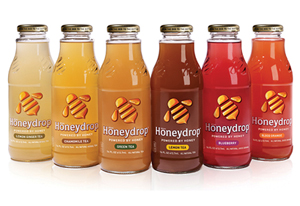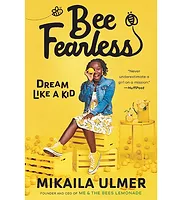The buzz about Honeydrop
Brand eyes expansion, helps bee population

|
With a lineup of six SKUs that are sweetened with a tablespoon of honey in each bottle, Brooklyn, N.Y.-based Honeydrop Beverages has a synergistic tie to the creatures that provide its natural sweetener. David Luks, founder and chief executive officer of Honeydrop Beverages, was initially inspired to create the brand by the growing research about the health benefits of honey, which reminded him of his grandmother’s daily lemon tea and honey, and childhood snacks of apples or peanut butter with honey.
“I felt that there was this lack of a space for people like me who always loved honey, and maybe there was an opportunity to bring them something, which led me to Honeydrop,” Luks says.
Honeydrop launched in 2009 with Blood Orange and Blueberry juice drinks and Chamomile brewed herbal tea. At the time, Luks was buying honey from different suppliers and repeatedly heard about Colony Collapse Disorder, a phenomenon that has decreased the U.S. bee population in recent years. In the 2010-2011 winter alone, total losses from managed honeybee colonies nationwide were 30 percent, according to a May 2011 study by the U.S. Department of Agriculture (USDA) and the Apiary Inspectors of America. Colony Collapse Disorder does not have one recognizable cause, but the USDA reports that it might be linked to pesticides, environmental stresses or a new parasite, pathogen or virus.
“As someone who is a self-proclaimed foodie, before 2009 I did not know how big the issue was,” Luks says. “Because bees pollinate one-third of all the produce we eat — 100 percent of avocados, 100 percent of almonds and 90 percent of cherries, apples and oranges — without bees all of a sudden we don’t have a third of our produce. We’re talking about a massive, massive issue.”
Because its products rely on honey, the company created its Buy A Bottle-Save A Bee campaign. One percent of the proceeds from each bottle of Honeydrop are donated to the brand’s network of local beekeepers, Luks explains. The company partners with professional beekeepers in the areas in which it has distribution and forms an agreement.
“We literally write a contract with that beekeeper that says within this defined geographic territory 1 percent of proceeds in that market will be going to you, Mr. Beekeeper, because you are our professional beekeeper, you are a responsible beekeeper, you have experience doing this and you will take those proceeds and build beehives,” Luks says. “That’s the solution: every beehive actually increases the bee population by 40,000 to 60,000 bees.”
Sweet inspiration
Luks began learning more about the health benefits of honey after his diagnosis of stage 1A cancer in 2006. The cancer was caught early and Luks did not need to undergo chemotherapy or radiation, but was kept under surveillance for five years. In 2008, Luks met with a nutritionist who gave him an article about honey, which outlined that honey is an unrefined sugar that naturally contains vitamins, minerals and antioxidants and metabolizes slower than refined sugars and provides sustained energy, he explains.
“As a former runner, it really resonated with me and specifically triggered a memory: ‘Oh, wow, that’s why all of my former running partners used to take a tablespoon of honey before they went running,’” Luks says.
From there, Luks began researching brands claiming to have a honey component and found that many were sweetened with refined sugars and incorporated honey flavor, which provided an opening for a product that was sweetened with real honey, he says.
The first three Honeydrop varieties — Blood Orange, Blueberry and Chamomile — were chosen because the flavors paired well with honey and have functional benefits, such as antioxidants from the fruit juices and chamomile’s inherent relaxation properties. Honeydrop Chamomile is made with brewed Egyptian chamomile flowers and tends to appeal to consumers who are a little bit older and regular users of hot chamomile tea, Luks says.
During its outreach for the first three flavors, consumers highlighted new options for Honeydrop, he says. “As we were sampling, literally every consumer was like ‘Where’s your green tea and honey? Where’s your black tea and honey? Where’s your ginger and honey?’” Luks explains.
At Natural Products Expo West in 2011, Honeydrop expanded its line with the introduction of three new varieties each sweetened with a tablespoon of honey: Green Tea that also includes echinacea, Lemon Tea made with black and white tea, and Lemon & Ginger formulated with brewed ginger.
Honeydrop’s sales are not overtly dominated by one of its six SKUs, Luks says. Trendy flavor Blood Orange is Honeydrop’s most popular option and makes up 20 percent of Honeydrop’s overall sales. Lemon Ginger accounts for 17 percent of sales followed by Lemon Tea and Green Tea at 16 percent each, he explains. Chamomile and Blueberry are not far behind with share in the mid to low teens, he adds. The wide appeal of the portfolio speaks to Honeydrop’s overall brand proposition.
“We have these SKUs, which don’t necessarily target the same consumer; it’s more about attracting different consumers who are unique in the mindset that they are definitely looking for something with honey,” Luks says. “Whether that’s from a sports standpoint because they want something with added energy or because they want something that’s unrefined or low in calories or because it’s just naturally good and it naturally has vitamins, minerals and antioxidants.”
The company also is planning to release new products in the next few months, which will follow its formula of varieties that are recognizable with honey, Luks says.
Spreading the word
Honeydrop’s lineup is available nationally in natural foods outlets through natural foods distributors. The company considers these shoppers its core target because they already understand the health benefits of honey, Luks says.
“When I’m sampling in a natural foods store and I start telling shoppers about why a tablespoon of honey is good, I literally have people put their hand in my face and say, ‘I know.’ It’s amazing,” he says.
The company combines its retail outreach and education with participation at events where educated consumers and honey fans might be in attendance, including food, running, yoga and athletic events, Luks says. Honeydrop also is active in local beekeeping associations, which Luks says is a byproduct of its Buy A Bottle-Save A Bee campaign. Honeydrop attends the biweekly events of the New York City Beekeeping Association and also is active with the Santa Barbara Beekeeping Association, he says.
“That’s our core constituency, those individuals who are so knowledgeable about what’s happening with the bees and really love our product for what we are doing and how we make it,” he says.
In addition to reaching out to natural foods consumers, Honeydrop also recognizes an opportunity to educate mainstream consumers about the benefits of honey and Colony Collapse Disorder.
“A lot of those benefits are not known when you go outside of the natural foods channel, and it’s our job to educate consumers,” he says. “So what we’ve been trying to do is focus on a couple of core metro markets: New York City, which is our backyard, and then on the West Coast in San Francisco and southern California as well as New England, to see if we can get nice recognition of our brand and loyalty of our brand outside the natural foods channel.”
Luks hopes Honeydrop’s current lineup and its upcoming releases will help the brand grow beyond natural foods stores in the company’s current markets and foster broader consumer loyalty with a goal to “get people in those markets who aren’t honey lovers to become honey lovers,” he says. BI
Looking for a reprint of this article?
From high-res PDFs to custom plaques, order your copy today!



